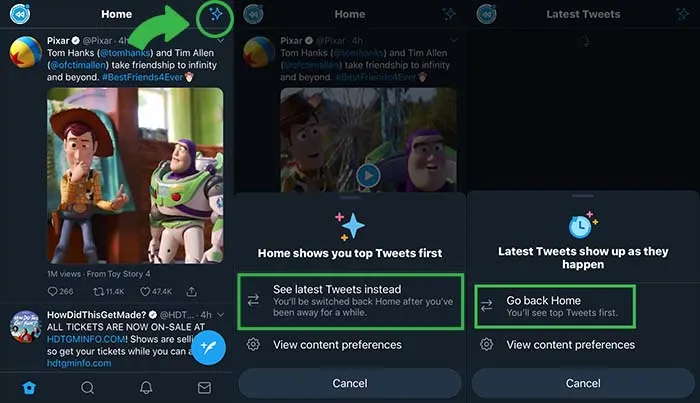Last September, Twitter announced that users would be able to switch between a Top Tweet view and a chronological Latest Tweets timeline.

1/ We’re working on new ways to give you more control over your timeline. But first, some context: Twitter helps you see what’s happening by showing the best Tweets for you based on your interactions.https://t.co/H5nuhQy3r2
— Twitter Support (@TwitterSupport) September 17, 2018
So, people now can move between an algorithm-based feed and a chronological timeline. This is something Facebook and Instagram have stayed away from in an effort to be relevant and engaging or whatever.
But just because the algorithm is optional doesn’t mean that everyone is opting out in favor of an old-school chronological feed.
Below, we’ll look at some of the key ranking signals you can expect to find inside your account.
What are the ranking signals?
As is the case with Facebook and Instagram, Twitter’s algorithm depends on a handful of ranking signals.
In 2019, the algorithm-based feed consists of the following sections:
Top Tweets
Top tweets are determined by the algorithm. Users will see content from accounts they follow, as well as content from their followers and suggested accounts.
Users also have the option to provide feedback on the content displayed in this section. This allows them to see some types of posts less often.
Latest Tweets
Latest Tweets represent a reverse chronological feed containing tweets from your followers.
ICYMI (In case you missed it)
In case you missed it, this is a compilation of top tweets determined by the algorithm. ICYMI is typically displayed to users who haven’t logged in lately. Frequent users won’t see this content much.
Happening Now
This is a section that appears at the top of your timeline, featuring trending topics and current events.
Trends for You
Another section determined by the algorithm, Trends for You highlights content that Twitter has determined to be relevant or interesting based on past activity.
You’ll have the option to customize this content by going into the Content Preferences section of your account.
As is the case with Facebook and Instagram, Twitter’s algorithm depends on a handful of ranking signals.
Here’s a quick look:
Recency
When was the tweet published? Timing weighs heavily into the Twitter algorithm, even if the user opts out of the algorithmic feed.
Rich media
Rich media refers to posts that contain video, audio, or GIFs, which encourage viewers to engage with the content. In other words, Twitter gives preferences to posts that contain more than a stock photo and a one-liner. That helps explain why this video just exploded:
This baby is having a full-fledged conversation with his father 😭❤️
This is the cutest thing ever 😍. Obsessed.
(via f/b Shanieke Pryor)
Retweet ❤️ pic.twitter.com/5ePvmx3ezo
— StanceGrounded (@_SJPeace_) June 5, 2019
Engagement
Engagement refers to how many tweets, impressions, replies, and clicks a tweet has received. It also takes into account how often people engage with the author’s account. It also factors the engagement of a tweet relative to other tweets posted by that same user.
Why chronological matters

Chronological content is one of the few ways that you can access neutral information in the aggregate format of a social media channel.
When you’re looking at something like top posts, that means that the platform’s algorithm is making a judgment call on your behalf. It is deciding what information you’re likely to click on, not which news stories are the most important or what is happening in real time.
We’ve become increasingly critical of what kind of content we see while scrolling mindlessly through social media.
Twitter’s move to allow people to opt out of the whole algorithm thing is actually a big deal.

Where Facebook has stated on multiple occasions that the algorithm offers users a better experience, it’s hard to separate that push toward engagement from the value it offers to advertisers.
Switching back to the chronological feed on a desktop is a matter of navigating to your account settings and unchecking the box that says “Show the Best Tweets First.”

On your phone, click the little star icon and it will open options for you to flip back and forth between “top tweets” and “latest tweets.”

How to make sure people see your Tweets
Despite having the option to skip the algorithm in favor of an orderly feed, many people are likely going to stick to the curated feed.
With that in mind, here are some tips for making sure that your content gets in front of as many eyeballs as possible.
Use hashtags
The hashtag was actually created on Twitter as a means of helping people find tweets and accounts they might find interesting. To this day, adding a hashtag is one of the best ways to get “discovered.”
Respond to your followers
Because one of the key ranking factors is “engagement,” you’ll likely get more visibility in others’ feeds if you retweet, like, comment, or reply on the platform.
As we’ve seen with Facebook and Instagram, there’s been a real push toward getting people to engage more with others, rather than focusing on collecting more followers.
Add visuals
This draws back to the idea that rich media tweets do better than those without any compelling visual elements. It’s well-documented at this point that social media content depends on visual aids.
Take it a step further and diversify your feed by adding in video clips, live videos, GIFs, and audio.
Don’t be afraid to max out character limits
Yes, the whole concept of Twitter is based on brevity.
This is why there was a bit of controversy when the social media platform doubled the character limit — going from 140 to 280. That said, it seems that the expansion has created an opportunity for more engagement.
According to Twitter research, they found that Japanese users were able to say more with fewer characters, which led to more valuable conversations.
Bottom line
Just because Twitter has the option to toggle between chronological and algorithm based feeds doesn’t mean everyone is opting out of the algorithm.
This means if you want to get the best possible results, you’ll need to play to the algorithm’s rules.

New Twitter feature has more Retweet options
read now

